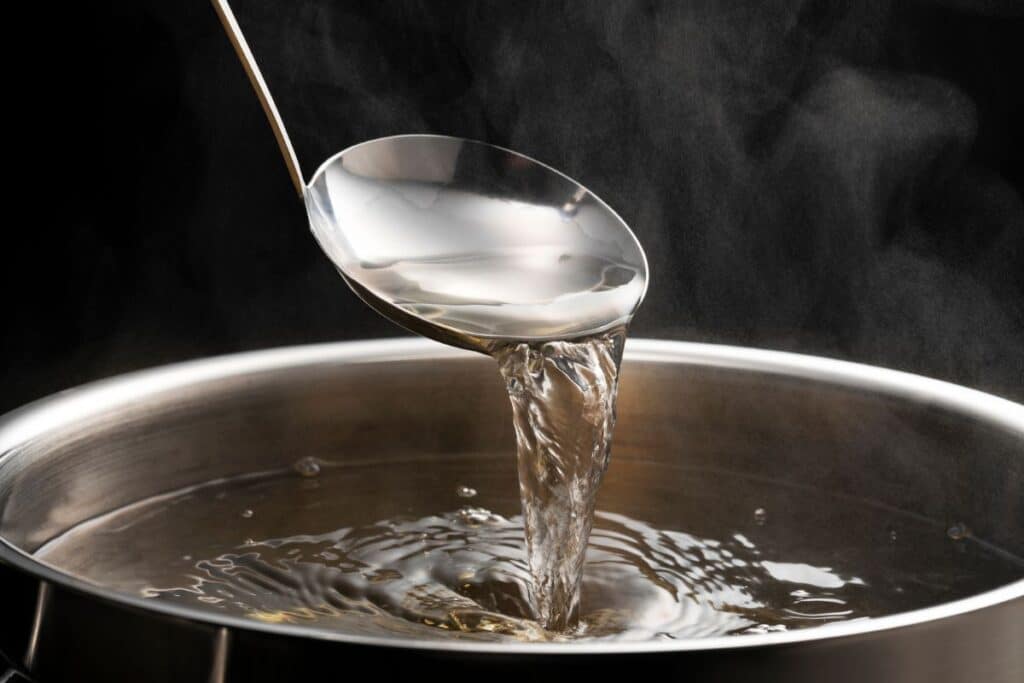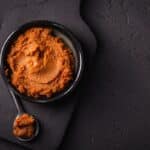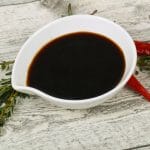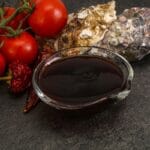Quick summary: Primar alternatives to dashi would be hondashi, chicken stock powder, monosodium glutamate, or white fish broth. But there are plenty of other substitutes, such as shellfish stock, soy sauce, shoyu sauce, and more.
Known as the backbone of Japanese cuisine, dashi soup stock forms the base of many Japanese dishes. It is used for miso soups, noodle broths, as a simmering liquid, and mixed into batters for okonomiyaki (Japanese savory pancakes) and takoyaki (small octopus-filled dough balls).
If you are planning on adding some Japanese to your cooking repertoire, it is very likely that dashi will be on your ingredients list.
Unless you have easy access to a Japanese grocery store or market, this is not something that is readily available.
Just because you don’t have any dashi on hand, doesn’t mean you have to skip those incredible umami flavors. Simply choose from the best dashi substitutes below and keep cooking.
What Is Dashi?
Although dashi comes in different varieties, the most common type is made by heating kombu (dried kelp) and preserved tuna or bonito (fish flakes) in water to near boiling.
Once sufficiently infused to make an umami-rich clear broth soup, the liquid is strained. Dried anchovies or sardines are also used. Popular types of dashi for vegans or those that need to avoid seafood are shiitake mushroom dashi, vegetable dashi, and shojin dashi.
Dashi Uses
Besides being used as a base for soups and noodle dishes, dashi is also used as a simmering liquid for fish, eggs, and vegetables. It can be mixed with tempura and other batters, vinaigrettes, and be used as a chicken or fish brine. Dashi is also added to stir-fry and steamed fish dishes for extra umami depth.
Best Dashi Substitutes
1. Hondashi
Hondashi is essentially dashi stock in granular form. As with many ingredients today, the laborious homemade product has been substituted with this instant solution.
Many home cooks find this a much quicker alternative when cooking than making broth from scratch. Like other stock powders, instant dashi powder has a more pronounced flavor as a result of chemical flavor enhancers.
In the same way that stock powder comes in different varieties (chicken, beef, vegetable), hondashi also comes in different flavors. These include bonito, kombu/kelp, niboshi/sardines, and agodashi.
The granules are dissolved in water to make a dashi broth. Quick and easy for any Japanese dish.
2. Chicken Stock Powder
Something that’s readily available and makes for an easy substitution is chicken stock powder. It has a long shelf life so you can always keep it on hand.
The powdered broth should be dissolved in water according to the packet instructions, however, chicken stock powder can be very salty.
We recommend starting with a little less and then adding to taste until you get the intensity you want. Adjust the other seasonings in your dish if necessary to prevent overpowering saltiness.
If you need to cut back on salt for health reasons or have allergies to wheat, look for low-sodium or gluten-free stock powder.
3. Monosodium Glutamate (MSG)
Monosodium glutamate, or MSG, has gotten a bad rap in the past, but you might be surprised to know that it occurs naturally in food like tomatoes and cheese.
It enhances the flavor of foods with a deep umami savory flavor while only containing a third of the sodium content compared to regular table salt.
If you can’t find msg at your local grocery store, you should be able to find it at an Asian supermarket.
The white powder is made by fermenting sugar beet, starch, sugar cane, or molasses in a similar way to wine and vinegar.
In terms of getting a wonderful, concentrated umami flavor, monosodium glutamate is one of the best substitutes for dashi.
4. White Fish Broths
White meat fish are species such as catfish, tilefish, cod, haddock, halibut, bass, and snapper that feed on the bottom of the ocean or lakes.
These non-oily fish have a mild flavor and firm but moist texture. When simmered in water with seasonings such as celery, garlic, and onion, this makes a fantastic substitute.
Note that fish such as tuna or mackerel are not suitable for this application since they have a pungent fish taste that can easily overpower other flavors as opposed to providing umami depth.
5. Shellfish Stock
If you have some time on your hands, making a stock by extracting the flavors from shellfish will make an excellent substitute.
Shellfish can include anything from shrimp, crayfish, and crab, to scallops, lobster, oysters, clams, and mussels. Most shellfish have a soft texture and mild, salty flavor. Some types also present delicate sweet flavor notes.
Although this can be a time-consuming way to substitute dashi, making a stock with shrimp or prawns and adding seasonings such as garlic, white wine, and black pepper can help you achieve a very similar flavor profile.
You can even add tomato paste and fresh thyme. This is also a great way to use any leftover shells, heads, or tails instead of throwing them away.
The little extra effort is worth the remarkable taste sensation!
6. Soy Sauce
Soy sauce is another commonly available ingredient that can easily replace dashi. This Chinese staple is made from fermented soybeans and has a rich, salty, umami flavor.
It is used in everything from marinades and sauces to broths, meat-, and vegetable dishes. It is also used in dumpling dishes, soup, stews, rice-, and egg dishes.
Although this makes a good dashi substitute, there are a few things to keep in mind when grabbing soy sauce as your replacement.
Soy sauce is very salty and concentrated. As with dashi granules, you only need to dissolve a small amount in water.
The upside is that you can control the flavor intensity by adding more or less. We do, however, recommend starting with just a small amount to create your ‘broth’ to prevent the saltiness from overpowering other flavors.
If you need to cut back on salt in your diet, look for a low-sodium variety. Soy contains gluten and of course, soy, so if you’re allergic to either of these choose a different substitute.
If you aim for the best quality after opening, here’s how to store it and how long soy sauce will last.
7. Shoyu Sauce
Shoyu sauce is another Japanese staple ingredient. It is very similar to Chinese soy sauce and is made and used in much the same way, but may be harder to find.
Although it still has a high salt content, it is less salty than soy. Use it in the same way by diluting a spoonful in water and adding to taste according to the intensity required.
8. Kombu Tea
Kombu tea comes in a powdered form. This is ideal to create a substitute for kombu-based dashi. If you don’t have kombu tea but your local Asian supermarket has dried seaweed, you can make your own.
Soak the kombu seaweed in water for at least two hours. Heat it up and simmer for three minutes. Discard the kombu and add a squeeze of lemon juice, ginger, and a few drops of light soy to round off the flavor.
9. Tororo Kombu
Tororo kombu is a processed kombu product made of shredded, salted kelp. The kombu is mixed with water or vinegar, formed into blocks, and then shaved into flakes which are commonly used as a garnish over noodles, rice bowls, and soup.
It has a salty, umami taste and makes a great vegan substitute. You can prepare it in the same way as kombu leaves or tea. You will find that it is dusted with a light white powder. Don’t wash this off, just place it straight into the liquid as this is where a lot of the flavor comes from.
10. Dried Bonito Shavings
Dried bonito flakes or shavings (also known as katsuobushi) are shavings from bonito fish that have been dried, smoked, and fermented.
Bonito has an intense fish flavor and firm texture. The flakes have added saltiness and smoky notes.
Ideally, you’d want to create a broth from the flakes as with tororo kombu. If you don’t have the time to soak them and cook up a broth, simply sprinkle a few into your dish to add some umami flavor.
11. Dried Shiitake Mushroom Soup Stock
Dried shiitake mushrooms have a richer and more concentrated flavor than fresh mushrooms since all the water has been removed during the dehydration process.
To use these mushrooms as a substitute, soak them for 30 minutes in water. Alternatively, simmer them to speed up the flavor-release process. You can also add some kombu or other vegetables if desired.
Strain the stock and add salt, pepper, or desired seasonings to taste. Instead of throwing away the dehydrated mushrooms, you can use them in stir fry, stews, rice dishes, or other recipes. Always cook shiitake mushrooms before eating.
If you refrigerate the broth overnight before using it, the flavor will develop even further.
12. Fish Stock
If you are out of options, turn to fish stock as your last resort. Fish stock should only have a subtle fish taste. Even so, it won’t pair well with all flavor profiles so consider this before using it as your replacement.
Fish stock is generally available at grocery stores, or you can make your own by simmering fish scraps and bones with vegetables and seasoning. The flavors should be well-balanced and not intensely fish-forward.
FAQ
Dashi will last a couple of days in the refrigerator (make sure to keep it covered). If you are not going to use it within two or three days, freeze it. Dashi will last for up to three months in the freezer.
The liquid should be pale brown and clear without being cloudy or murky. There should be no residue from the steeping ingredients.
Boiled kombu is edible but will have a very rubbery texture so won’t be pleasant to eat on its own.
Dashi is a staple in Japanese cooking but not easy to find if you don’t have an Asian supermarket nearby. For a quick fix, grab some soy sauce or chicken stock.
If you have access to ingredients like kombu tea, dried shiitake mushrooms, or bonito flakes, these will give you the added umami depth you’re looking for.
When making your own broth, make sure to soak your ingredients long enough to extract maximum flavor. Taste before adding seasonings to avoid overpowering other flavors in your dish.
There are a lot of ways you can experiment to get the perfect flavor profile for your personal preference. Happy cooking!
*image by sai0112/depositphotos









